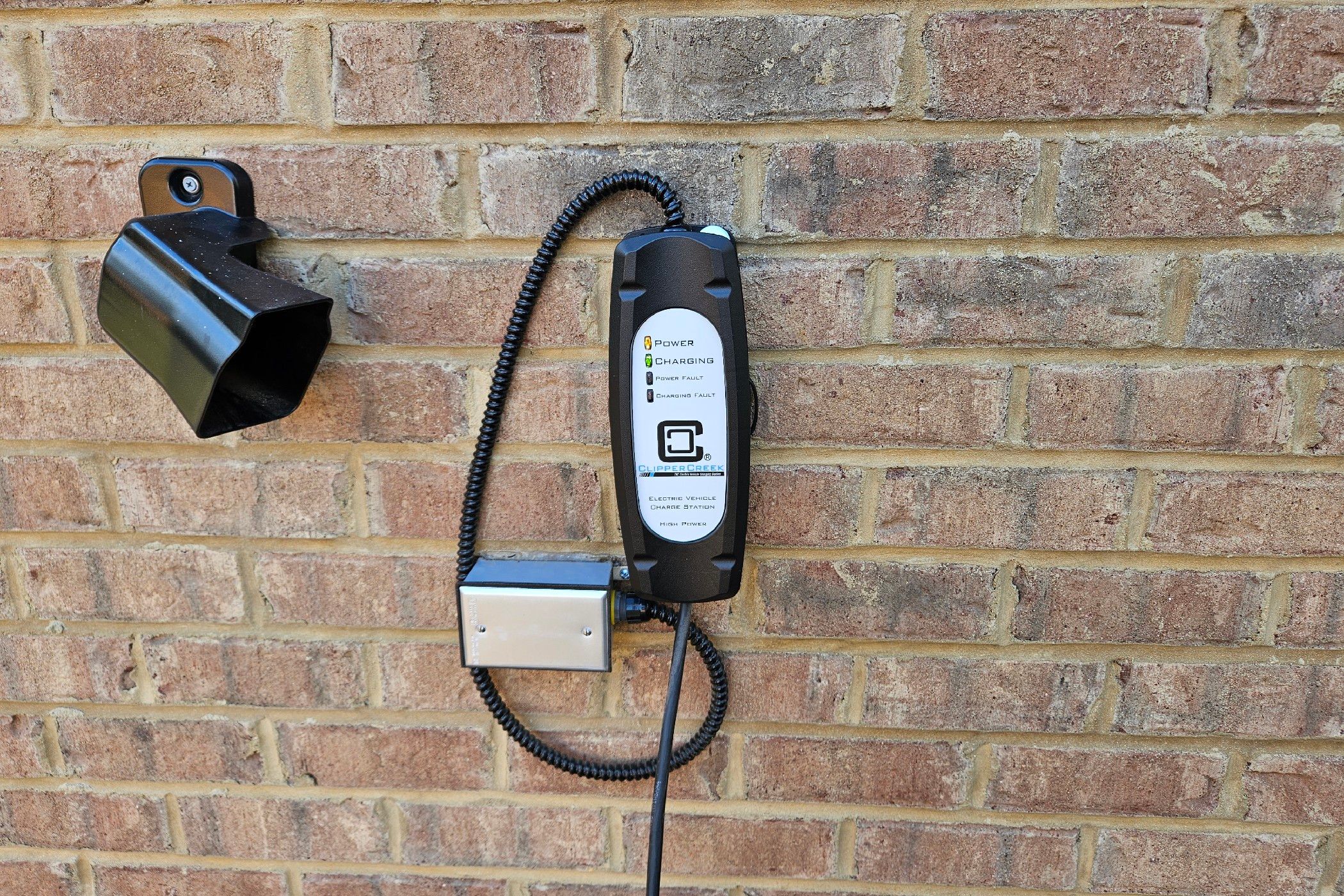
Troubleshooting Electric Car Charger Woes: A Guide to Identifying and Fixing 8 Common Malfunctions

Troubleshooting Electric Car Charger Woes: A Guide to Identifying and Fixing 8 Common Malfunctions
Key Takeaways
- A charge may not initiate due to connection issues or your car’s charging schedule.
- Extensive charging from a power outlet can trip a breaker or lead to electrical issues, especially on buildings with older wiring.
- Network outages, malfunctioning units, payment issues, and extreme weather can all lead to trouble at a public charging station.
Sometimes you plug your car in to charge and, well, nothing happens. If this happens to you and you don’t feel a sense of panic, well, kudos to you. For most of us, this is when we start freaking out. I’ve been there, and here is what I’ve learned along the way.
1 Is the Charging Plug Inserted Securely?
This is pretty intuitive. Most of us will immediately shimmy the plug a little bit to see if it’s in all the way, but what precisely are we checking for?
The NACS charging plug that Tesla developed for its vehicles (and is gradually being adopted by most car manufacturers in North America) relies on the vehicle to latch it into place. The J1772 and CCS connectors found on most non-Tesla EVs in the US have their own built-in latches in addition to your vehicle’s ability to lock it into place. If these names don’t mean anything to you, here’s an overview of EV terms , including the various types of connectors.
In either case, if you don’t hear a latch, then the charge may not start because the plug isn’t securely in place.
2 Is Your Car Set to a Charging Schedule?
Okay, so everything is plugged in properly and things still aren’t working. You plug the car in, it beeps or flashes a light to acknowledge the plug, but it still doesn’t charge. In that case, it may be worth double-checking if you have the car set to a charging schedule.
A car set to charge overnight won’t charge right away when you plug it in during the day. You will either need to turn off the schedule or temporarily override it. Each carmaker has their own way of doing this, so you may need to dig out the owner’s manual or hit up YouTube.
A car following a charging schedule will typically have a light flash in a way that indicates its plugged in but not currently charging. So, if the light that comes on when you plug in your car looks different than usual, start by checking your charging settings.
3 Did You Trip a Breaker?

Bertel King / How-To Geek
What about when no light comes on at all? If you’re at home, then you may have tripped a breaker. Yup, it happens with kitchen appliances, and it can happen with your car too.
This is an issue you’re more likely to encounter if you’re charging using a regular wall outlet, which is sometimes referred to as Level 1 charging . Cars pull around the maximum amount of current an outlet is capable of producing, and if you’re plugged into one that’s on the same circuit as another heavy appliance, the breaker will trip if you try to do both at the same time.
You probably won’t face this issue if you’re using a dedicated home charging station, also known as Level 2 charging, but you never know!
4 Is Your Charging Cable or Power Outlet Damaged?
Charging from a wall outlet is not the ideal way to charge an EV, but it’s one many of us rely on. Most EVs come with a wall charger, and if you don’t have a lengthy commute, an overnight charge can provide enough juice to get around town.
But when you charge an EV from a wall outlet every day, you run the risk of overheating the outlet. Other appliances may draw as much electricity as your EV, like a microwave or an electric skillet, but they don’t run for a dozen hours at a time. That’s a heavier load being supplied for a longer time than outlets are expected to manage. The situation is riskier if you’re charging in a decades-old home with aging electrical wiring.
I speak from experience. I’ve fried an outlet once after charging an EV near-constantly for several months. I drove around often enough that by the time the wall outlet had recharged my car, it had only a few hours to rest before I returned and plugged my car back in. One day, nothing happened when I tried to charge my car, and it took me a while to figure out what was going on. Then I noticed my power plug and the outlet were charred. Thankfully, there wasn’t a fire.
If you find yourself in a situation where you’re charging your car most of the day, every day, it’s really worth getting a dedicated charger or, if you can’t, looking for public charging. Fortunately, there are plenty of apps to help you find public EV charging stations .
5 Is the Charging Network Down?
Most public chargers are part of a network. There are many different competitors, such as Tesla, Electrify America, EVGo, and ChargePoint in the US. When you plug your car in, there’s a lot of internet communication going on behind the scenes. If the network is down for any reason, the charge won’t initiate.
This situation is rare, but it has been known to happen. Electrify America has had outages that temporarily left chargers inoperable all along an interstate corridor. For this reason, it’s worth checking for warning signs using an app like PlugShare before going on a long road trip. If you encounter this challenge on the road, your only fallback is to search for another provider. Maybe you’ll luck out and find a charging network that’s cheaper .
6 Is There an Issue With the Charging Station?
It’s rare that the entire network is down, but it’s rather commonplace on some networks for individual charging stations to be down. It’s like pulling up to a gas pump with a sticky note on the glass saying out-of-order, except there’s no attendant there to put up a note. Sometimes the station will tell you it’s down. Often enough, you won’t know until you plug in and nothing happens.
In that case, you can usually move to a nearby charger, since most locations have more than one charging station available. Unfortunately, on busy days, this often means waiting in line for other cars to finish charging first.
7 Is There a Payment Issue?
I once had a confounding experience trying to re-use a charging station I had already been visiting regularly every few days, only this time it wasn’t working. The station appeared functional. There weren’t any PlugShare reviews saying it was having issues. What gives?
Turns out, the credit card tied to my account had expired. I didn’t receive any kind of email notification or on-screen feedback from the machine that there was a payment issue. I didn’t know what was up until I called customer support, and we tried various other fixes first. We discovered what was going on when we attempted to initiate a charge over the phone and I read the credit card number, which was declined. After I updated the card on my account, the charge proceeded to work.
8 Is It Very Hot or Cold Outside?
Charging a car may seem conceptually similar to filling one up with gas, but the reality is much more complicated. Electricity behaves nothing like a liquid, and providing enough juice to recharge your car in a matter of minutes is a very complicated affair.
Public charging stations have been known to have issues if it’s very hot outside. I’ve encountered this myself, experiencing a session start and spontaneously stop after only a few minutes, over and over again.
Fast chargers can also face issues when temperatures are too far in the opposite direction. Attempting to charge on a frigid day will likely take longer to charge, but if temperatures plunge deep enough, it may not work at all.
Unfortunately, your only option here is to look for a Level 1 or Level 2 charger, which generally works regardless of temperature. Only that’s not much use if you’re racing down the interstate with somewhere to be, facing the likelihood of being late or, far worse, stranded.
Many prospective EV drivers have range anxiety, but from my experience, that goes away rather quickly as you grow accustomed to charging your car at home and get a feel for how far you can go. Most modern cars can easily handle our daily commutes. It’s charging on long-distance trips where the anxiety really kicks in. It’s one thing to know a charging station exists, but often enough, you don’t know for sure that it will work until you’re plugged in and start receiving power. The best you can do is be informed, knowledgeable, and prepared while we wait for the charging infrastructure to become as reliable as the EVs they power.
Also read:
- [New] The One Stop Guide to Simplified Podcast Live Broadcasting
- [Updated] 2024 Approved How to Convert YouTube Videos to MP3 Songs on Mac
- [Updated] Streamline Your Media with Top 8 Convertors #1-8
- [Updated] Top 10 Strategies for YouTube-to-MPEG Conversion
- 1. Fixing HEVC Encoded Videos with Misaligned Soundtracks: Identifying Reasons & Remedies
- 2 Ways to Transfer Text Messages from Xiaomi Redmi Note 13 Pro 5G to iPhone 15/14/13/12/11/X/8/ | Dr.fone
- 2024 Approved Enhancing Engagement How to Use Background Footage
- 2024 Approved Streamlining Social Media Posts with SRT File Integration Tips
- 2024 Approved The Ultimate Voice Changer A Detailed Manual on MorphVOX Transformation
- 2024 Approved Unraveling WhatsApp's Voice Transmission Techniques
- Fascination Frameworks IG's Most Popular Filters for 2024
- Harmonizing Windows 11, 8, 7 & MF4770n for Efficiency
- How to Unblock the Login Sequence in Windows 10 & 11
- In 2024, Streamlining Film Grading with CG Central's Look-Up Tables
- In 2024, The Easy Path to Engaging Animation in Your Videos
- In 2024, The Perfect Loop Technique for All Your YouTube Favorites
- Inside OpenAI's Innovation: The Evolution and Distinctions of Generative Pre-Trained Transformer Versions - GPT-1 to GPT-4 Decoded
- Top 5 Gaming Monitors to Perfect PS5 and Xbox Experience for 2024
- Unlock Your Kindle Books: Step-by-Step Tutorial on Eliminating DRM From AZW/AZW3/AZW4 Formats
- Title: Troubleshooting Electric Car Charger Woes: A Guide to Identifying and Fixing 8 Common Malfunctions
- Author: Mark
- Created at : 2024-12-27 16:16:46
- Updated at : 2025-01-02 16:35:21
- Link: https://some-guidance.techidaily.com/troubleshooting-electric-car-charger-woes-a-guide-to-identifying-and-fixing-8-common-malfunctions/
- License: This work is licensed under CC BY-NC-SA 4.0.